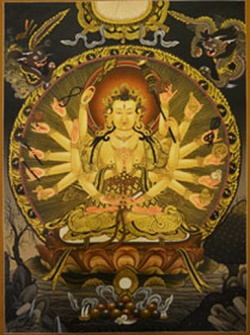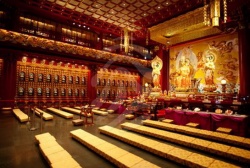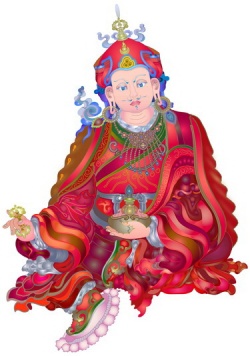Anathapindika's monastery
When the Buddha accepted Anāthapindika's invitation to visit Sāvatthi the latter, seeking a suitable place for the Buddha's residence, discovered this park belonging to Jetakumāra (MA.i.471 says it was in the south of Sāvatthi). When he asked to be allowed to buy it, Jeta's reply was: "Not even if you could cover the whole place with money." Anāthapindika said that he would buy it
at that price, and when Jeta answered that he had had no intention of making a bargain, the matter was taken before the Lords of Justice, who decided that if the price mentioned were paid, Anāthapindika had the right of purchase. Anāthapindika had gold brought down in carts and covered Jetavana with pieces laid side by side. (This incident is illustrated in a bas-relief at
the Bharhut Tope; see Cunningham - the Stūpa of Bharhut, Pl.lvii., pp. 84–6). The money brought in the first journey was found insufficient to cover one small spot near the gateway. So Anāthapindika sent his servants back for more, but Jeta, inspired by
Anāthapindika's earnestness, asked to be allowed to give this spot. Anāthapindika agreed and Jeta erected there a gateway, with a room over it. Anāthapindika built in the grounds dwelling rooms, retiring rooms, store rooms and service halls, halls with fireplaces, closets, cloisters, halls for exercise, wells, bathrooms, ponds, open and roofed sheds, etc. (Vin.ii.158f).
It is said (MA.i.50; UdA.56f) that Anāthapindika paid eighteen crores for the purchase of the site, all of which Jeta spent in the construction of the gateway gifted by him. (The gateway was evidently an imposing structure; see J.ii.216).
Jeta gave, besides, many valuable trees for timber. Anāthapindika himself spent fifty-four crores in connection with the purchase of the park and the buildings erected in it.
The ceremony of dedication was one of great splendour. Not only Anāthapindika himself, but his whole family took part: his son with five hundred other youths, his wife with five hundred other noble women, and his daughters Mahā Subhaddā and Cūla Subhaddā with five hundred other maidens. Anāthapindika was attended by five hundred bankers. The festivities in connection with the dedication lasted for nine months (J.i.92ff).
The vihāra is almost always referred to as Jetavane Anāthapindikassa ārāma (Pali, meaning: in Jeta Grove, Anathapindika's Monastery). The Commentaries (MA.ii.50; UdA.56f, etc.) say that this was deliberate (at the Buddha's own suggestion pp. 81–131; Beal: op. cit., ii.5 and Rockhill: p. 49), in order that the names of both earlier and later owners might be recorded and that
people might be reminded of two men, both very generous in the cause of the Religion, so that others might follow their example. The vihāra is sometimes referred to as Jetārāma. Jetavana Anathapindikarama (Anathapindika’s monastery in Jeta’s grove ). Anathapindika asked the Buddha the appropriate way to gift the monastery to Him. The Buddha then requested
Anathapindika to donate the park by dedicating it to the Sangha of the present and the Sangha of the future. The Buddha then encouraged others in the building of monasteries by highlighting the benefits of such a gift to the Sangha. Anathapindika questioned the Buddha on a suitable place for His residence. On hearing that the Buddha was seeking a quiet place for His retinue and Himself to spend the rainy season, Anathapindika looked for a suitable park to make available to Him.
The park which Anathapindika chose for the Buddha was the lush garden of Prince Jeta (King Pasenadi Kosala’s son). The Prince, however, was not selling his beautiful park. When the persistent Anathapindika would not relent from his request to buy the park, the exasperated Jeta said, "Cover the entire garden with 100,000 gold coins." This was an unreasonably high price even for a park as beautiful as his. To his surprise, Anathapindika accepted and soon carts arrived bearing thousands and
thousands of gold coins that he strew all over the garden. His curiosity now aroused, Jeta asked Anathapindika the reason for which he needed the park. On hearing that it was for the Buddha and His retinue he relented and handed over the park to Anathapindika.
The Vinaya Pitaka describes the quarters Anathapindika built as a vast complex with monasteries, attendance halls, meditation cells, bathrooms, lotus ponds and walkways - a beautiful complex that would be worthy of the Buddha. Some of the chief buildings attached to the Jetavana are mentioned in the books by special names, viz., Mahāgandhakuti, Kaverimandalamāla, Kosambakuti
and Candanamāla. SNA.ii.403. Other buildings are also mentioned - e.g., the Ambalakotthaka-āsanasālā (J.ii.246). According to Tibetan sources the vihāra was built according to a plan sent by the devas of Tusita and contained sixty large halls and sixty small. The Dulva (Vinaya-pitaka in Tibetan)also gives details of the decorative scheme of the vihāra (Rockhill: op. cit.48 and n.2).
All these were built by Anāthapindika; there was another large building erected by Pasenadi and called the Salalaghara (DA.ii.407). Over the gateway lived a guardian deity to prevent all evildoers from entering (SA.i.239). Just outside the monastery was
a rājayatana-tree, the residence of the god Samiddhisumana (Mhv.i.52f; MT 105; but see DhA.i.41, where the guardian of the gateway is called Sumana).
In the grounds there seems to have been a large pond which came to be called the Jetavanapokkharanī. (AA.i.264; here the Buddha often bathed (J.i.329ff.). Is this the Pubbakotthaka referred to at A.iii.345? But see S.v.220; it was near this pond that Devadatta was swallowed up in Avīci (J.iv.158)).
The grounds themselves were thickly covered with trees, giving the appearance of a wooded grove (arañña) (Sp.iii.532). On the outskirts of the monastery was a mango-grove (J.iii.137). In front of the gateway was the Bodhi-tree planted by Anāthapindika,
which came later to be called the Anandabodhi (J.iv.228f). Not far from the gateway was a cave which became famous as the Kapallapūvapabbhāra on account of an incident connected with Macchariyakosiya (J.i.348).
According to the Divyāvadāna (Dvy.395f), the thūpas of Sāriputta and Moggallāna were in the grounds of Jetavana and existed until the time of Asoka. Both Fa Hien (Giles: p. 33ff) and Houien Thsang (Beal.ii.7ff) give descriptions of other incidents connected with the Buddha, which took place in the neighbourhood of Jetavana - e.g., the murder of Sundarikā, the calumny of Ciñcā, Devadatta's attempt to poison the Buddha, etc.
The Gandhakuti: Buddha's dwelling in Jetavana
The space covered by the four bedposts of the Buddha's Gandhakuti in Jetavana is one of the four avijahitatthānāni; all Buddhas possess the same, though the size of the actual vihāra differs in the case of the various Buddhas. For Vipassī Buddha, the setthi Punabbasumitta built a monastery extending for a whole league, while for Sikhī Buddha, the setthi Sirivaddha
made one covering three gavutas. The Sanghārāma built by Sotthiya for Vessabhū Buddha was half a league in extent, while that erected by Accuta for Kakusandha Buddha covered only one gāvuta. The monastery of the Koṇāgamana Buddha, built by the
setthi Ugga, extended for half a gāvuta, while that of the Kassapa Buddha built by Sumangala covered sixteen karīsas. Anāthapindika's monastery covered a space of eighteen karīsas (BuA.2, 47; J.i.94; DA.ii.424).
According to a description given by Faxian (Giles, pp. 31, 33), the vihāra was originally in seven sections (storeys?) and was filled with all kinds of offerings, embroidered banners, canopies, etc., and the lamps burnt from dusk to dawn.
One day a rat, holding in its mouth a lamp wick, set fire to the banners and canopies, and all the seven sections were entirely destroyed. The vihāra was later rebuilt in two sections. There were two main entrances, one on the east, one on the west, and Faxian found thūpas erected at all the places connected with the Buddha, each with its name inscribed.


